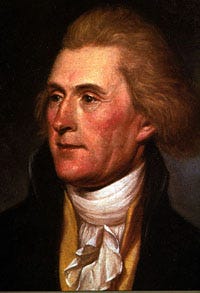Dear Readers: As you read this, my husband & I will be driving from the Free State of South Dakota to the Marxist State of Washington. Our beach house is just a bicycle ride from where Captain Clark arrived on the shores of the Pacific Ocean, when our nation was young, healthy & growing. Enjoy this brief respite from the chronic ailments that are now plaguing our nation. Diane
Little Tommy Jefferson was born in 1743. The idea of exploring the country between the Mississippi River and the Pacific Ocean first entered his thoughts as a child. Between 1750 & 1756 Jefferson’s father, his father’s friend and Jefferson’s teacher were discussing exploration plans through their involvement with the Loyal Land Company. Before the French & Indian War intervened, that friend, Thomas Walker, had been chosen to lead a party west over the Appalachian Mountains with the following instructions:
“. . . in search of that river Missouri in order to discover whether it had any communication with the Pacific Ocean, . . to follow the river if they found it, and exact reports of the country they passed through, the distances they traveled, what worth of navigation those rivers and lakes, etc.”
Immediately after the Revolutionary War (1776), Jefferson (then a new member of the Virginia House of Delegates) initiated the first of his four ideas about exploring the West. The first person he contacted was war hero General George Rogers Clark, older brother of William Clark, who agreed with the need for such exploration. However, Clark declined to undertake this task due to prior commitments.
Early on during his tenure as America’s minister to France Jefferson learned that Louis XVI had designs on establishing a French colony in the Pacific Northwest. This troubled him, so he met with John Ledyard who had previously sailed to the Pacific Northwest with the British explorer Captain James Cook (1776-1779).
Ledyard told Jefferson that he could travel overland from Poland through Russia, across the Bering Sea, to the West Coast of North America. The year was 1786. Jefferson was supportive, but there is no record that he provided Ledyard with any assistance. Good thing, as Ledyard did not get past Siberia where he was arrested by Empress Catherine the Great of Russia and sent back to Poland.
As America’s first secretary of state, Jefferson came up with yet another idea to explore the West in 1792. Early that year an American sea captain, Robert Gray, had sailed his ship Columbia into Columbia River’s estuary. [The Columbia River now divides the states of Washington & Oregon.] The discovery of this great river in the West and its location, added to the knowledge previously gained by Cook’s travels. Secretary Jefferson now knew the continent was about 3,000 miles wide.
Spurred on by Jefferson, in 1793 the American Philosophical Society offered one thousand pounds to the explorer who made it to the Pacific Ocean and back, and reported on it. Meriwether Lewis volunteered, but Jefferson thought him too young at age 18. Instead, he chose French botanist Andre Michaux for this task and wrote the instructions:
“to find the shortest & most convenient route of communication between the U.S. & the Pacific Ocean, within the temperate latitudes.”
Unfortunately, Michaux only made it so far as Kentucky when he was called back. Jefferson had discovered that he was a spy for the French Republic.
Just weeks into his presidency (1801) Jefferson learned that Spain had secretively transferred Louisiana back to France. This greatly alarmed him as this was Napoleonic, revolutionary, expansionistic France. He flatly declared that he would consider any attempt to land French troops in Louisiana a cause for war.
In 1803 Jefferson convinced congress to buy the territory of Louisiana from the French Republic for $15 Million, or approximately eighteen dollars per square mile, for the 828,000 square miles which would triple America’s land mass.
And the rest, as they say, is history.



